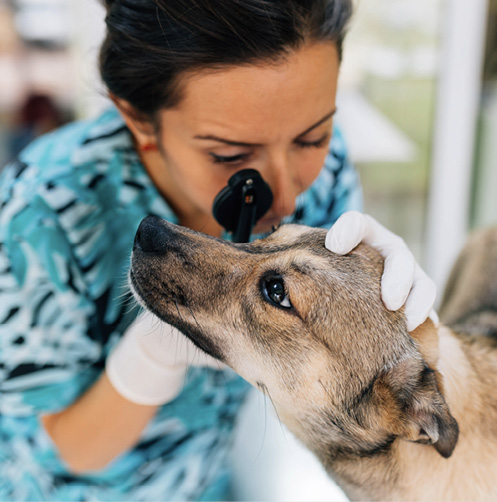Veterinary Technician Specialists
An Established Solution for a Rising Problem
In human nursing, there are extra qualifications a registered nurse (RN) can attain to become what is known as an advanced practice registered nurse (APRN). Standard titles for such practitioners include nurse practitioners (NPs), clinical nurse specialists (CNSs), and certified registered nurse anesthetists (CRNAs), to name a few. The APRNs fill many gaps in human healthcare, given the lack of MDs (physicians), and have more autonomy than their nonspecialized colleagues. In veterinary medicine, though, we are not quite there yet. Or are we?
Before I delve into the secret weapon veterinary medicine has but is not fully utilizing, we need to take a step back and look at one of the linchpins of the veterinary profession: credentialed veterinary technicians. Credentialed veterinary technicians are individuals who have graduated from an American Veterinary Medical Association (AVMA)-accredited veterinary technology program, or who used an alternate route to qualify to sit for the veterinary technicians national exam (VTNE).
The VTNE is administered by the American Association of Veterinary State Boards and is North America’s most widely accepted veterinary technician credentialing exam. Unfortunately, veterinary technicians crossing state lines are still faced with state-by-state credential requirements where credentials do not always transfer.

Despite VTSs not being able to perform additional tasks when compared with a credentialed veterinary technician, hiring a VTS will add value to your hospital.
Many states still do not require credentialing for team members to perform specific skills in the veterinary practice, as delegated by the veterinarian. Any noncredentialed or nonlicensed person in a veterinary practice is properly and legally called a veterinary assistant. Veterinary assistants are an enormously important part of the veterinary team. Some states have adopted more formalized education and training for veterinary assistants and offer training via approved veterinary assistant courses; these graduates earn the title certified veterinary assistant (CVA).
A growing number of state veterinary practice acts (VPAs) include credentialed veterinary technicians with varying titles, such as certified veterinary technician (CVT), licensed veterinary technician (LVT), registered veterinary technician (RVT), and licensed veterinary medical technician (LVMT). Our Canadian neighbors have adopted the title of RVT across all provinces.
No US state legally recognizes or endorses the title “veterinary nurse” or any variation of a title that includes “nurse” thus far, despite many legislative efforts to enact that change over the last five years. The American Nurses Association has vowed to defend their legally protected title nationally, including filing a letter of complaint with the Federal Trade Commission against organizations using the term “nurse” both with or without the “veterinary” descriptor before the word.
Regardless of company culture, or if one is making an effort to be supportive, calling any of your team members in North America a “nurse” is inappropriate and, in a majority of US states, illegal. To date, title enforcement has been lax, as seen by the flagrant use of “veterinary technician,” “vet tech,” and “tech” being used to describe veterinary assistants.
Once a credentialed veterinary technician has years of experience, many often wonder, what’s next? Numerous certificate and certification programs exist for the veterinary team members, including Fear Free, Human Animal Bond, RECOVER CPR, physical rehabilitation certifications, and so on. However, many of these are offered by private organizations and are typically not regulated or accredited more officially, as we would expect from one of the 23 AVMA-approved specialty veterinary colleges that board certify specialty veterinarians (known as Diplomates).
The State of VTS
There are currently 16 veterinary technician specialty academies, with more on the horizon. These academies mirror the veterinarian specialty colleges and offer certifications that experienced credentialed veterinary technicians can attain. These academies go through an annual review process overseen by the National Association of Veterinary Technicians in America (NAVTA) with recognition from the AVMA. Each academy is required to submit a letter of support from their respective veterinarian specialty college. Individuals that complete the rigorous application process and pass the certifying exam are known as veterinary technician specialists (VTSs). Have you never heard of them before? That is not uncommon given that there are fewer than 1,500 VTSs worldwide, despite the first academy being founded more than 30 years ago.
How Does One Become a VTS?
That question is best answered by visiting each academy’s website. Generally speaking, candidates must have worked as a credentialed veterinary technician for a minimum of three to five years. The candidate must spend a majority of their time working in the specialty that aligns with the candidate’s interest. For example, if I were interested in obtaining the anesthesia and analgesia VTS, I would need to spend 75% of total work hours in a five-year period to meet the hours required for applying. Most VTS academies define “a majority” of an individual’s time as 70% or greater in the specialty they are applying for, though individual academies’ requirements may vary. NAVTA is creating a searchable database for the profession and the public to verify an individual’s VTS (it will be published on NAVTA’s website: navta.net).
Pay
There are two studies by Norkus et al. (2016) and Gilliam et al. (2020) that found credentialed veterinary technicians with a VTS credential had only nominal increases in hourly pay but did have the potential for greater income with more opportunities to speak, write, or offer consultation services outside of their regular job. Many VTSs describe wanting to become a VTS as a personal and professional opportunity for growth while also opening many more doors in their careers.
Veterinary Technician Specialists in Practice
What can a VTS do compared with a non-VTS credentialed veterinary technician? As mentioned, the model of a VTS is similar to a boarded veterinarian specialist. From a legal perspective, there is no difference in allowed tasks—the same as the difference in what a DVM/VMD is legally allowed to do when compared with a diplomate. However, we as a profession have come to respect and rely on specialists for services or knowledge. Specialized veterinarians and veterinary technicians have more standardized advanced training and exposure to more complicated procedures or techniques and often have a broader knowledge base, hence the term “specialist.”
Only a few states thus far, such as Tennessee and California, have acknowledged VTSs in their practice acts. The California veterinary practice act was recently updated and includes title protection for VTSs; the new law says that individuals may refer to themselves as a “veterinary specialist” or “board certified” only if they are a VTS or diplomate.
Despite VTSs not being able to perform additional tasks when compared with a credentialed veterinary technician, hiring a VTS will add value to your hospital. Someone who has gone through the extra steps to become a VTS can help manage more intense or complicated cases, train staff, create protocols, or do anything else that is not prescribing medications, performing surgery, diagnosing a condition, or developing a prognosis. Currently, some states are researching the interest and feasibility of allowing VTSs to do additional veterinary healthcare tasks over and above what their current scope of practice allows.
In a small survey (n=37), an overwhelming majority of veterinarians supported allowing VTSs to prescribe certain noncontrolled medications (with limitations); to perform minimally invasive procedures under indirect supervision (such as simple dental extractions, wound debridement, and suturing); and to induce, maintain, and monitor anesthesia under indirect supervision. If this idea moves forward, it could establish the first real advanced practice veterinary technician (APRVT) role.
This author is aware of some discussion of a “mid-level practitioner” with a few universities interested in creating a master’s degree. While this may be intriguing for some, there has been no corresponding effort to revise or amend state veterinary practice acts to allow these graduates to do anything more than what a veterinary assistant or credentialed veterinary technician can do. There is currently only one university piloting an online program that aims to create this type of role. The mid-level practitioner discussion and nascent programs beg the question of necessity and spark ethical concerns in creating and marketing these programs with little to no return on investment, given the near poverty level wages currently being paid in the veterinary profession. A more practical solution would be to push for VTSs in the advanced practice veterinary technician role instead.
Elevating VTSs’ roles in practice acts would also utilize already established exams and processes instead of needing to create a new exam or application/requirement process. Though, utilizing VTSs as an advanced practice veterinary technicians will require some modification and training if certain areas like limited prescribing powers, minor surgical interventions, and outpatient case management were to become legal.
 |
Stephen Cital, RVT, SRA, RLAT, CVPP, VTS- LAM (Res. Anesthesia), is an educator, author, researcher, and veterinary anesthesia/analgesia and cannabis expert. Cital works at the Howard Hughes Medical Institute at Stanford University School of Medicine in the Department of Neurobiology. In addition to conducting research, Stephen is an award-winning international lecturer on anesthesia, pain management, cannabis, and best practices. |
Photo credits: xavierarnau/E+ via Getty Images Plus; razyph/iStock via Getty Images Plus




